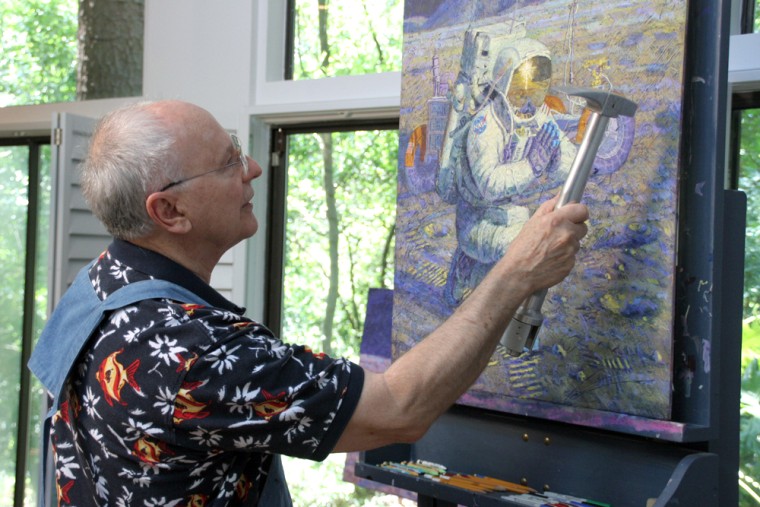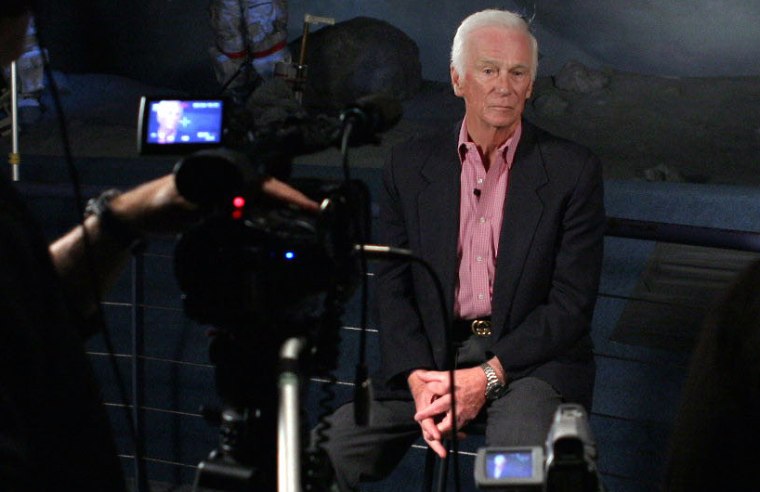As Russia and the world commemorate another Cosmonauts Day on Thursday —the 46th anniversary of the first human flight into space — one of the most amazing realizations is that the man who made that flight, Yuri Gagarin, would be only 73 years old today if he hadn’t been killed in a jet crash while training for his next mission.
At 73, Gagarin would have been expected to have developed a lifetime’s perspective on his experience and would have been able to place it in a thoughtful, cultural context. He would have been able to describe what it really felt like in the few moments he had free from the highly scripted procedures of his flight.
Fortunately, a large number of other spaceflight pioneers — specifically, men who have walked on the moon — have led long lifetimes after their space feats. They’ve been able to think deeply about their experiences and experiment broadly with communicating them to the public. And even more fortunately, an independent documentary film production team has captured those thoughts and presented them in digestable form.
The documentary is called “The Wonder of It All,” and it will have its premiere at the Newport Beach Film Festival late next week in California. I was fortunate to attend a private screening of the film earlier this year in Houston. I could compare it with the private conversations I’ve had myself with some of the Apollo moonwalkers as a friend and colleague. I could see how it stacked up against the dozens of other shows, books and multimedia presentations about space history. And I came away most impressed.
Slideshow 12 photos
Month in Space: January 2014
Of the 12 men who have walked on the moon, three (Pete Conrad, Alan Shepard and Jim Irwin) are now dead. One moonwalker — Neil Armstrong — chose to share his own insights under conditions over which he had more creative control. Another, Apollo 15 commander Dave Scott, independently developed his own documentary looking back on the Apollo missions.
But every other moonwalker — Buzz Aldrin, Alan Bean, Edgar Mitchell, John Young, Charlie Duke, Gene Cernan, and Jack Schmitt — took part in this production. They discussed both what they did and what they thought about it, then and now. “The wonder of it all” is a phrase that dropped from the lips of Charlie Duke, and it aptly described their impressions of their own experiences.
Astronauts and cosmonauts are selected for many particular factors, and introspection is not one of them. They are highly intelligent, good learners, cool under pressure, perceptive, decisive, cooperative — but they are not philosophers. Or at least they didn’t start out that way. Fortunately, if they live long enough (as, sadly, Gagarin did not), many of them become reasonably good at philosophy, as this program shows.
What you will and won’t see
What viewers will not see is another rendition of “how we did it,” although there are plenty of fascinating and little-known comments about incidents along the way.
What viewers will see is men who have not only gazed into space, but have looked into their own souls as well. The producers developed sufficient rapport, and let the cameras run long enough through narrative pauses, for the interviewees to spontaneously blurt out thoughts they may never have spoken before — for example, Aldrin’s deeply personal description of the impact on him, prior to Apollo 11, of his mother’s unexpected suicide.

We’re all familiar with the broad outlines of the post-Apollo careers of these men:
Bean moved into graphic arts, struggling to express on canvas what the lunar environment really looked like beyond what mere cameras could capture. Mitchell ventured into paranormal studies — he secretly experimented with sending telepathic messages while in flight to and from the moon. Duke’s epiphany led him into traditional religious transformation, while Schmitt entered politics. Young came to see space technology as the only trustworthy long-term warden of Earth’s habitability, while Aldrin mapped the future courses of space vehicles and nations. Cernan has remained the pilot’s pilot, but was deeply moved to carry the responsibility of being the last man on the moon.
In this film, the men give examples of what they were thinking and feeling along those passages. Often, it seems, they surprise themselves with novel formulations of what had become formulaic repetitions of old stories. They speak to nobody’s agenda but their own, and in that freedom, provide the building blocks for vehicle that can transform its viewers.
Seamless editing
Most viewers probably won't notice the seamless editing achieved by the producers, as they took tens of hours of film of the musings and responses and asides of the seven men, arranged them thematically and sequentially to illustrate specific ideas, and then inserted a contextual narrative to explain and transition the comments. From what I know about the men interviewed, and about their actual experiences, the narrative is absolutely perfect — not one of the misunderstandings, misrepresentations, sensationalism or other diversions so often found, accidentally or on purpose, in other documentaries on this subject.
This rearrangement of the stream-of-consciousness narratives into a cogent, coherent exposition is illustrated by one delightful flub in continuity on the part of the interviewers. As clips from comments by one of the astronauts appear throughout the documentary, the books on a shelf behind him in his study arrange and rearrange themselves back and forth between two different configurations. Clearly, halfway through the interview, the cameraman had the idea to move a moon-related book into a more prominent position.
I noticed it only because of my own particular visual obsessions with backgrounds, and nobody else at the private screening recalled seeing it at all. It’s a very minor flub, but serves as an excuse to draw attention to the enormous effort the producers expended to make the comments and narrative flow logically rather than merely chronologically — an effort that succeeded magnificently.
One of the moonwalkers, Charlie Duke, said as much at last year's screening party. "I was very moved by the film,” he remarked. “I learned a lot [about the other guys], because we never talk about this when we get together. It's always the technical stuff. I've never seen a film that has such a depth of moonwalkers at the same time."
James Oberg, space analyst for NBC News, spent 22 years at the Johnson Space Center as a Mission Control operator and an orbital designer. He is the author of numerous books on the U.S. and Russian space efforts, including "Pioneering Space."

